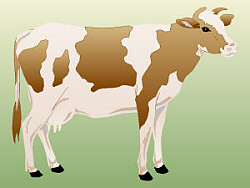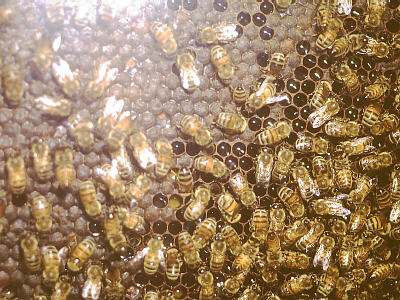But what, nutritionally, was in that cake? Actually, since
the organisms (cocoa tree pods, wheat seeds, cow’s milk, etc.)
from which the cake was made are composed of a bunch of chemicals, so is the
cake, and when we digest food, our bodies extract and use certain of those
chemicals. Most foods contain some
 .
Many foods contain some
.
Many foods contain some
 which have joined together to make
which have joined together to make
 .
Some foods contain a lot of
.
Some foods contain a lot of
 and sometimes some
and sometimes some
 .
Other foods, especially vegetables and fruits, contain some
.
Other foods, especially vegetables and fruits, contain some
 and/or some
and/or some
 .
I would imagine this chocolate cake also contains a lot of
.
I would imagine this chocolate cake also contains a lot of
 .
We tend to think of some of these chemicals as being “bad” for us and some as being “good”, but the
reality is that we need some of all of them in reasonable, moderate amounts.
.
We tend to think of some of these chemicals as being “bad” for us and some as being “good”, but the
reality is that we need some of all of them in reasonable, moderate amounts.
(Hint: Click on each of the chemical pictures for more information.)
The following Web pages contain information related to
diet, recipes, and the various nutrients in our food in addition to the links
in the previous paragraph.
In doing this project, you will learn something about diet
and nutrition, especially as it relates to your own diet. You will be asked
to look up this information on your own rather than having it supplied here,
to enable you to learn how to locate this information on your own and to make
informed decisions based on available facts. This assignment will take
several weeks of record-keeping to complete, so start early and plan ahead.
Read through the whole assignment so you understand what’s going on before
you jump in. The grading criteria for this assignment are given below, and
you should also refer to those as you work on the assignment.
A total of 100 points is possible.
| 1. Diet Journal: |
|---|
| 2 | — | All required diet journal information was included for all seven days |
| 1 | — | An attempt at a diet journal was made, but the diet journal was not kept for all seven days |
| 0 | — | No diet journal data were turned in |
 |
|---|
| 2 | — | Thorough, detailed notes and data were included |
| 1 | — | Some notes and data were included, but the diet journal is rather sketchy |
| 0 | — | Inadequate or no notes and data were included |
 |
|---|
| 2 | — | It is obvious that the student was paying attention to and thinking about how the foods being consumed were affecting his/her body |
| 1 | — | Some thought was given to the relationship between foods consumed and effects on the person’s body |
| 0 | — | It would appear that the student spent very little time thinking about how his/her diet was affecting him/her |
 |
|---|
| 2 | — | The student, obviously, went beyond the minimum requirements of the assignment |
| 1 | — | The student adequately completed the assignment |
| 0 | — | The student completed considerably less of the assignment than what was required |
| 2. List of Foods: |
|---|
| 2 | — | All food items listed in the diet journal were included here |
| 1 | — | Only some of the consumed foods were listed and/or foods were listed here that were not included in the diet journal |
| 0 | — | List of foods is missing |
 |
|---|
| 2 | — | Totals accurately reflect total amounts consumed |
| 1 | — | Totals do not match with reported amounts consumed |
| 0 | — | Totals are missing or grossly inaccurate |
 |
|---|
| 2 | — | Time was taken to organize the foods by food-group categories |
| 1 | — | Some attempt was made to group similar foods together |
| 0 | — | No organization to the list, related foods not grouped together |
 |
|---|
| 2 | — | The student, obviously, went beyond the minimum requirements of the assignment |
| 1 | — | The student adequately completed the assignment |
| 0 | — | The student completed considerably less of the assignment than what was required |
| 3. Nutrient Analysis: |
|---|
| 2 | — | Weekly totals were included for all nutrients listed in NAT plus a number of other important nutrients |
| 1 | — | Weekly totals were included for all nutrients listed in NAT |
| 0 | — | Weekly totals were not included for all specified nutrients |
 |
|---|
| 2 | — | All weekly totals were correctly calculated for each food, based on all the servings consumed during the week |
| 1 | — | Some weekly totals were incorrectly calculated because not all servings were included in the calculation, but most are OK |
| 0 | — | Many/all weekly totals were incorrectly calculated |
 |
|---|
| 2 | — | Daily averages were calculated and included for all nutrients listed in NAT plus a number of other important nutrients |
| 1 | — | Daily averages were calculated and included for all nutrients listed in NAT |
| 0 | — | Some or all daily averages not calculated/included |
 |
|---|
| 2 | — | All daily averages were correctly calculated |
| 1 | — | Some daily averages were incorrectly calculated, but most are OK |
| 0 | — | Many or all daily averages were incorrectly calculated |
 |
|---|
| 2 | — | The student, obviously, sought out and made effective use of a variety of resources |
| 1 | — | The student made good use of NAT as a resource |
| 0 | — | It appears that the student did not take advantage of the available resources |
 |
|---|
| 2 | — | The student, obviously, went beyond the minimum requirements of the assignment |
| 1 | — | The student adequately completed the assignment |
| 0 | — | The student completed considerably less of the assignment than what was required |
| 4. RDA and Comparison: |
|---|
| 2 | — | Recommended values were included for all nutrients listed in NAT plus a number of other important nutrients |
| 1 | — | Recommended values were included for all nutrients listed in NAT |
| 0 | — | Recommended values were not included for all specified nutrients |
 |
|---|
| 2 | — | Where the student’s recommended values differ from the US-RDA, it is obvious that this was intentional, based on careful research on and thought about recommendations of other nutritional experts |
| 1 | — | The student accepted the US-RDA values (as suggested in NAT) as his/her personal, recommended values |
| 0 | — | Where the student’s recommended values differ from the US-RDA, this seems to be due to inadequate research to determine what the recommended values are |
 |
|---|
| 2 | — | An analysis of the nutritional highs/lows/OKs was included for all nutrients listed in NAT plus a number of other important nutrients |
| 1 | — | An analysis of the nutritional highs/lows/OKs was included for all nutrients listed in NAT |
| 0 | — | An analysis of the nutritional highs/lows/OKs was inadequate or missing |
 |
|---|
| 2 | — | The high/low/OK selections suggest that the student spent a lot of time thinking about and analyzing the significance of his/her nutritional data |
| 1 | — | The high/low/OK selections suggest that the student correctly compared his/her nutritional intake numbers to the RDA values |
| 0 | — | The high/low/OK selections suggest that the student did not grasp the significance of his/her nutritional intake numbers |
 |
|---|
| 2 | — | The student, obviously, sought out and made effective use of a variety of resources |
| 1 | — | The student made good use of NAT as a resource |
| 0 | — | It appears that the student did not take advantage of the available resources |
 |
|---|
| 2 | — | The student, obviously, went beyond the minimum requirements of the assignment |
| 1 | — | The student adequately completed the assignment |
| 0 | — | The student completed considerably less of the assignment than what was required |
| 5. New Diet Plan and Nutrients: |
|---|
| 2 | — | A week’s-worth (seven days) of menu plans were included |
| 1 | — | Four to six days’-worth of menus were included |
| 0 | — | Three or less days’-worth of menus were included |
 |
|---|
| 2 | — | Daily amounts obtained were calculated and included for all nutrients listed in NAT plus a number of other important nutrients |
| 1 | — | Daily amounts obtained were calculated and included for all nutrients listed in NAT |
| 0 | — | Some or all daily amounts not calculated/included |
 |
|---|
| 2 | — | All daily totals were correctly calculated |
| 1 | — | Some daily totals were incorrectly calculated, but most are OK |
| 0 | — | Many or all daily totals were incorrectly calculated |
 |
|---|
| 2 | — | All menu plans for all days are designed to supply 100% of all nutrients |
| 1 | — | A few menu plans are slightly lacking in a few nutrients |
| 0 | — | Either amounts of many nutrients are not specified or many nutrients are seriously lacking for many of the days |
 |
|---|
| 2 | — | The menus suggest that the student spent a lot of time thinking about and attempting to meet his/her nutritional needs |
| 1 | — | The menus suggest that the student correctly compared his/her planned nutritional intake to the RDA values |
| 0 | — | The menus suggest that the student did not grasp the significance of his/her nutritional needs |
 |
|---|
| 2 | — | Several new food/menu items are included |
| 1 | — | At least one new food/menu item is included |
| 0 | — | No new foods are included |
 |
|---|
| 2 | — | The student, obviously, sought out and made effective use of a variety of resources |
| 1 | — | The student made good use of NAT as a resource |
| 0 | — | It appears that the student did not take advantage of the available resources |
 |
|---|
| 2 | — | The student, obviously, went beyond the minimum requirements of the assignment |
| 1 | — | The student adequately completed the assignment |
| 0 | — | The student completed considerably less of the assignment than what was required |
| 6. New Diet Journal: |
|---|
| 2 | — | All required diet journal information was included for all seven days |
| 1 | — | An attempt at a diet journal was made, but the diet journal was not kept for all seven days |
| 0 | — | No diet journal data were turned in |
 |
|---|
| 2 | — | Thorough, detailed notes and data were included |
| 1 | — | Some notes and data were included, but the diet journal is rather sketchy |
| 0 | — | Inadequate or no notes and data were included |
 |
|---|
| 2 | — | It is obvious that a conscious effort was made to follow the diet plan and obtain 100% of all nutrients |
| 1 | — | A number of unplanned “substitutions” were made that resulted in less-than-adequate nutrition |
| 0 | — | Many unplanned “substitutions” were made, to the point that the planned diet was not followed at all, resulting in poor nutrition |
 |
|---|
| 2 | — | It is obvious that the student was paying attention to and thinking about how the foods being consumed were affecting his/her body |
| 1 | — | Some thought was given to the relationship between foods consumed and effects on the person’s body |
| 0 | — | It would appear that the student spent very little time thinking about how his/her diet was affecting him/her |
 |
|---|
| 2 | — | The student, obviously, went beyond the minimum requirements of the assignment |
| 1 | — | The student adequately completed the assignment |
| 0 | — | The student completed considerably less of the assignment than what was required |
| 7. Summary and Comments: |
|---|
| 2 | — | Thorough, detailed notes and comments were included |
| 1 | — | Some notes and comments were included, but rather sketchy |
| 0 | — | Inadequate or no notes and comments were included |
 |
|---|
| 2 | — | It is obvious that the student was paying attention to and thinking about how the foods being consumed were affecting his/her body |
| 1 | — | Some thought was given to the relationship between foods consumed and effects on the person’s body |
| 0 | — | It would appear that the student spent very little time thinking about how his/her diet was affecting him/her |
 |
|---|
| 2 | — | The student, obviously, went beyond the minimum requirements of the assignment |
| 1 | — | The student adequately completed the assignment |
| 0 | — | The student completed considerably less of the assignment than what was required |
| 8. Questions (for each question): |
|---|
| 2 | — | Answer to question was correct |
| 1 | — | Answer to question was mostly correct |
| 0 | — | Answer to question was mostly or all incorrect or missing |
 |
|---|
| 2 | — | Answer to question was thorough and well thought-out |
| 1 | — | Answer to question was a bit vague and/or not totally logical |
| 0 | — | Answer to question was too sketchy/vague and/or did not make sense or was missing |
| Total Possible: |
|---|
| 100 | — | total points |
Adams, Catherine and Martha Richardson. 1981. Nutritive Values of Foods. USDA, USGPO. 34 pp. (lib # TX 551.A32)
(anon.) 1994. A Good-Sense Guide: Guide to the Foods you Eat. Black Dog & Leventhal Publ., Inc., New York. 432 pp. (jsc)
Gelb, Barbara L. 1978. The Dictionary of Food and What’s in it For You. Paddington Press, New York. 253 pp. (lib # TX 551.G28)
McGill, Marion and Orrea Pye. 1978. The No-Nonsense Guide to Food and Nutrition. Butterick Publishing, New York. 224 pp. (jsc)
Pennington, Jean A. T. and Helen Nichols Church. 1985. Bowes and Church’s Food Values of Portions Commonly Used, 14th Ed. Harper & Row, New York. xxvii + 257 pp. (or more recent edition) (jsc)
Robertson, Laurel, Carol Flinders, and Brian Ruppenthal. 1986. The New Laurel’s Kitchen. Ten Speed Press, Berkeley. 512 pp. (jsc)
Wong, Dominic W. S. 1989. Mechanism and Theory in Food Chemistry. Van Nostrand Reinhold, New York. xviii + 428 pp. (lib # TX 541.W66)
 ell now,
ell now,
 after all that volleyball, our players were getting pretty hungry, so they
decided to stop for lunch. Everyone brought along a lot of good food to
share, so all-in-all, there was a variety of healthy foods from which to
choose, including vegetables, salads, and casseroles, with meat and veggie
burgers on the grill, but of course, one thing that was very popular was the
chocolate cake. Did you know that chocolate cake is “biological”? Let’s
look first at the ingredients, and then, the cake’s nutritional value.
after all that volleyball, our players were getting pretty hungry, so they
decided to stop for lunch. Everyone brought along a lot of good food to
share, so all-in-all, there was a variety of healthy foods from which to
choose, including vegetables, salads, and casseroles, with meat and veggie
burgers on the grill, but of course, one thing that was very popular was the
chocolate cake. Did you know that chocolate cake is “biological”? Let’s
look first at the ingredients, and then, the cake’s nutritional value.












